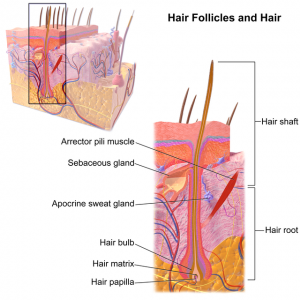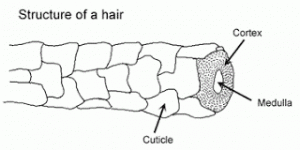The anatomy of hair and hair follicles for FUE hair transplants
HAIR LOSS
We explore the anatomy of hair and the hair growth cycle to better understand why hair falls out and how we can restore it.
Hair. It’s something we’re more attached to than we’d probably like to admit. One survey reported that 60% of hair loss patients would rather have hair than money or friends, while a report by The Mirror stated that 94% men put losing hair as their number one fear.
To understand why hair loss occurs, we have to understand the anatomy of hair or, in particular, the anatomy of the kind of hair we’re most loathed to lose; terminal hair, the thick stuff that covers our heads.
Each terminal hair on our head has two separate structures; the hair follicle which is under the skin, and the hair shaft which is what we see.
Hair follicle
Often described as a ‘stocking-like’ structure, the hair follicle is located under the skin and surrounds the base of the hair root. At the bottom of the follicle is a small projection called a papilla, which contains tiny blood vessels called capillaries tasked with feeding the only living part of the hair; the bulb. The cells in the centre of the bulb are responsible for how our hair grows and divide every 23-72 hours, the fastest of any part of the body.
Attached to each follicle is a tiny collection of muscles called the arrector pilli, which have the responsibility of making the follicle stand more perpendicular to the surface of the skin. Also attached to each follicle is a sebaceous gland, which produces an oily substance called sebum to naturally condition the hair. Sebum production increases in adults after puberty, but interestingly then decreases (significantly so in women) over our lifetime. The follicle has two protective layers referred to as the inner and outer sheaths; the inner follows the hair shaft, ending just before the opening of the sebaceous gland, while the outer sheath protects the hair all the way up to the bulb.

Hair shaft
When the cells within the follicle’s bulb divide, they push up older cells which slowly die. These dead cells create what we see of the hair. The shaft is 88% composed of a hard fibrous type of protein called keratin, which rests in three layers; medulla, cortex, and cuticle. The medulla is the innermost layer and nearly invisible, with currently very little understanding on its exact purpose. The cortex, which is the middle layer, makes up the majority of a hair shaft and contains most of the hair’s pigment, while the cuticle (the top layer) is formed of densely packed overlapping scales and has a main role of protecting the hair.

Hair growth
Understanding the different parts of hair, then, getting to grips with its growth then becomes clearer. There are three main phases of hair growth to consider:
Anagen Phase
This is the active growth phase of the hair, and occurs when the cells in the follicle’s bulb divide rapidly. This phase adds roughly 1cm to the hair shaft every four weeks. Normally 90% of hair is in the anagen phase at any one time, with scalp hair often remaining in this phase for around 2-7 years.
Catagen Phase
Signalling the end of the active growth of a hair, the catagen phase lasts around 2-3 weeks and is when the follicle stops producing hair and pigment, shrinking to roughly 1/6 of its usual length. The base of the follicle moves to the surface of the skin, while the papilla breaks away to rest below and a new hair begins to form in the bulb. The existing hair, however, does not fall out.
Telogen Phase
Under 1% of your hair sits in the telogen, or resting, phase at any point in time. During this period, which lasts between 2-4 months, the hair will not grow but will remain attached to the follicle before it is shedded.
The times for these different phases are not the same for facial and eyebrow hair, but it does still follow the same process.
Hair Transplants
Considering the delicate structure of each hair then, it becomes clear how much knowledge is required in removing hair for hair transplant purposes. Surgeons need to remove and reinsert the hair’s neurovascular bundle and sebaceous gland as well as the strand and follicle, making it highly meticulous and very skilled.
At The Private Clinic we work with two of the UK’s most qualified and experienced hair surgeons and boast a team of some of the most skilled hair technicians and doctors. We are able to successfully restore patients’ hair by understanding the anatomy of hair, and will never go ahead with a procedure that we believe will be unsuccessful. We work exclusively with the FUE method of hair transplantation where individual strands of hair are extracted directly from the scalp for transplantation, meaning less risk of scarring and a much speedier recovery. Understanding each follicle has led our surgeons to help pioneer this methodology; hair restoration can only be successful when those performing it get to the very root of what makes hair grow.
Our team’s advanced skills mean we are able to provide a range of FUE hair transplant procedures including standard FUE hair transplantation to the head, unshaven FUE hair transplants, facial hair transplants and eyebrow transplants.
Find out more.








